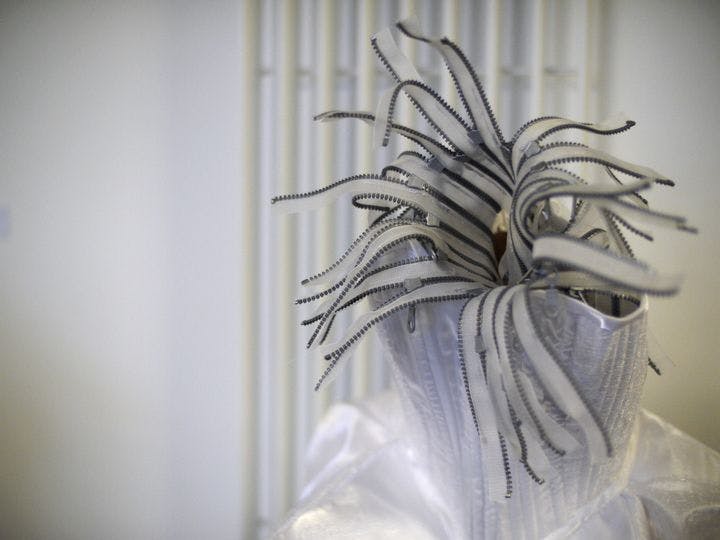Fall 2010
Story Material
– Andrew Starner
The oscillation of fashion between reality and fiction, static display and animate object, makes "The Concise Dictionary of Dress" intriguing.
In a 2000 exhibition at London’s Victoria and Albert Museum titled “Papiers à la Mode: Paper Fashions,” Belgian artist Isabelle de Borchgrave and collaborator Rita Brown painstakingly recreated dozens of dresses from 300 years of fashion in white drafting paper twisted to look like braid, delicately buttoned and drawn into bows, and otherwise manipulated. Borchgrave elaborately painted most of these whimsical ensembles to mimic the silk and damask of the originals; the few pieces that were not given this treatment functioned like a window into fashion’s unconscious—they looked more than anything like the pages of a book tortured into expressive shape.
The catalog to another show that was up this spring at the Victoria and Albert Museum, which houses the world’s largest collection devoted to decorative arts and design, appears to perform the inverse operation: It shoehorns a succession of three-dimensional garments into a two-dimensional book. The message of “The Concise Dictionary of Dress”—the name of the exhibition as well as the catalog—is that clothing functions simultaneously as textile and text, sensuous object and intellectual exercise. A visit to nearly any museum can offer a window into another time and place, but an exhibition of historical costumes encourages a corporeal engagement: to imagine the feel of a corset or the weight of a brocade.
Sponsored by the London-based arts commissioning agency Artangel, the exhibition allowed visitors a behind-the-scenes view of the Victoria and Albert Museum’s monumental storage facility at Blythe House. Visitors took a private tour of 11 tableaux created by Judith Clark, a lecturer at the London College of Fashion who codirects the master’s program in fashion curation (the existence of which signals the increasing importance of fashion in museum collections), and Adam Phillips, a psychoanalyst and writer. Garments culled from storage, commissioned for the exhibition, or created by Clark herself were tucked into Blythe House’s vast galleries of ceramics, textiles, and drawings, as well as in its underground coal bunker and on the roof overlooking West London.
The thrust of Clark and Phillips’s creations isn’t the indefinability of fashion, but rather its proliferating meanings. Each entry in The Concise Dictionary of Dress—devoted to an installation in the exhibition that represents a word such as provocative or essential—has a single page of definitions followed by several pages of photographs. Phillips’s quirky, almost metaphysical take on fashionable—the meanings he lists include “a form of alarm” and “excited impatience with the body”—gives an idea of how the exhibition and this book frustrate conventional expectations. Clark’s accompanying illustration consists of eight wig forms arranged in a glass cabinet, displaying, among other articles, a sequined headdress in the style of a 1930s hairdo, a knitted hood, and a barrister’s curled headdress.
Readers may get a fuller experience of the installations (which were devoid of wall texts and labels) than did museumgoers, thanks to the illuminating end matter, which includes detailed information about the objects on display as well as a colloquy on fashion in which Clark fields anonymous questions from notable thinkers from a variety of disciplines, including Shakespeare scholar Stephen Greenblatt and art historian T. J. Clark (no relation to the lead curator). By masking her interlocutors’ identities, Judith Clark elicited adventurous questions—her inspired response to “Do you believe in ghosts?” will forever alter your experience of second-hand clothing shops.
Although the word costume has fallen out of favor among fashion curators, it evokes the duality of dress, which can be a form of make-believe (donning another’s clothing) or just as easily a form of authenticity (self-fashioning one’s identity). This oscillation of fashion between reality and fiction, static display and animate object, makes The Concise Dictionary of Dress intriguing. The wonderful photographs by Norbert Schoerner, accompanied by minimal text, make reading it akin to watching an engrossing silent film with just enough subtitles to convey the plot. Terse and brittle, it is an art-house primer on the intersection of fashion, sexuality, performance, and art. While it cannot explain the current phenomenal success of outré music performer Lady Gaga or what her outrageous outfits mean, it does illustrate that we live in a world where what is on the surface speaks volumes about what lies beneath.
* * *
Andrew Starner is a graduate student in theater and performance studies at Brown University.
Reviewed: The Concise Dictionary of Dress by Judith Clark and Adam Phillips, photographs by Norbert Schoerner, Violette Editions, 136 pp, 2010.
Photo courtesy of Flickr/the justified sinner
